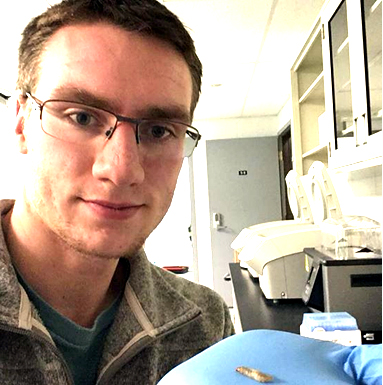|
|

|
  
Features
Update 2020/3/27 Teachers' Hub
brought to you in part by

CAN PLASTIVORE WORMS EAT OUR PLASTIC POLLUTION AWAY?
Brandon University students look into it
By Suzanne Forcese
The most commonly used form of plastic worldwide, polyethylene, has resulted in an accumulation in our landfills and waterways. Because of its resilience to natural degradation we are now faced with a global plastic pollution crisis. What if there would be a way to accelerate plastic degradation by mimicking some key take-aways from nature’s own symbiotic relationships?
Brandon University’s Department of Biology has recently published research findings on a unique relationship between plastivores-- waxworms with their microbiome. Together they have a voracious appetite for polyethylene plastic.
WaterToday spoke with two Masters students in the Environmental and Life Sciences Program who have been working with Dr. Bryan Cassone and Dr. Christophe LeMoine. Sachi Villanueva and Harald Grove also co-authored the paper with Drs. Cassone and LeMoine.
|  |
Always reminded of the poor healthcare system of her native Philippines, first year Master’s student, Sachi Villanueva’s dream is to become a doctor. “I was not aware of research,” she told WT until I learned of the Cassone Lab. “I was fortunate to receive a NSERC grant to facilitate women in research which allowed me to spend the summer of 2017 in the lab. I enjoyed it so much I continued working with Dr. Cassone and Dr. LeMoine in 2018.”
|
Harald Grove, who is in his second year of a Masters program, like Villanueva, has his sights set on being a doctor and continuing his research. “I think it’s why Sachi and I are such a great team.”
Grove’s interest in research was sparked when he heard about research in the Cassone Lab on waxworms and their ability to digest plastic. Grove, who spends summers working at an apiary close to his family’s farm in Gilbert Plains, Manitoba, thought to himself, “I know all about those guys.”
Waxworms, the caterpillar larvae of the greater wax moth (Galleria Mellonella) are a threat to beekeepers because they feed on the honeycomb, with the potential to destroy a hive and become a further threat to crops. |  |
“We were inspired by the work of Federica Bertocchini, an amateur bee-keeper in Spain, who just happened to be a scientist,” Villanueva said. Bertocchini had cleaned out her hive of the pests and placed them in a plastic bag for disposal when she later noticed the caterpillars had eaten their way out. With her follow-up experiments, Bertocchini discovered the waxworms were digesting plastic rather quickly because of their gut bacteria.
The reason waxworms are prone to feasting on plastic bags “is that polyethylene is like honeycombs in that both are composed of long chains of carbon and hydrogen,” Grove adds.
“We think waxworms may have evolved to degrade plastic,” Villanueva says of future research. Interestingly, worms that were starved or fed on their natural honeycomb diet did not do as well as those fed on plastic in the Cassone Lab.
Bertocchini’s research was released in a 2017 paper “which opened the doors for an in-depth study of the gut microbiome of the waxworm and what synergistic effects the bacteria endowed to the caterpillars,” Grove said.
The team was able to isolate the bacteria, Acinetobacter, which has been associated with polyethelene degradation. It was observed that the bacteria were able to survive on nothing but plastic for one year.
“We found that when we treated the worms with antibiotics their ability to digest plastic was impeded because the bacteria were killed,” Grove continues, “even after the course of antibiotics.” This suggests there is a synergy between the bacteria and the worms. While it appears that waxworms play an important role in the biodegradation process, the contribution of its intestinal microbiome presents a strong relationship in the acceleration of the degradation process.
“We also looked at the excreta of the worms,” Grove says. “Worms that were not fed plastic left little black pellets. Those that consumed plastic excreted a white liquid. There is something going on in how the plastic is metabolized.”
Villanueva adds, “upon examination, the liquid was found to be a glycol alcohol product – ethylene alcohol. It is what is found in anti-freeze.
Both Villanueva and Grove underscore the fact that although promising at this point waxworms and their gut buddies are not a realistic solution to the world’s plastic pollution. Although 60 waxworms in the lab were fed only polyethylene plastic for one year, it was observed that 30 square centimetres of plastic could be devoured in a week. Also, the larval stage only lasts for 3-4 weeks after which they form cocoons and emerge as greater wax moths which do not eat.
“There is still much to learn,” Grove says. “There are already over 50 different known types of bacteria and fungi that can degrade plastic but at a much slower rate. What is unique about our findings so far is the relationship between the
microbiome and the waxworm. We can also learn more about the mysterious waxworms and what allows them to survive on a plastivore diet.”
The hope for future research is to harness what is in the gut bacteria that helps the caterpillars break down plastic and to use that unknown factor to design better ways to eliminate plastic.
Villanueva - who has been an active member of the community both on and off campus as a residence mentor and settlement partner for the WUSC (World University Service of Canada) - adds, “We believe it is important to continue our research to find solutions to our plastic pollution legacy but prevention is even more important. Everyone has to do their part.”
Grove is also very thankful for funding that he has received through NSERC to continue research. “The wonderful thing about being part of a small university is the opportunity to really get to know your professors and their research. The downside however is lack of funding opportunities.”
Both Grove and Villanueva are involved with Let’s Talk Science where they are taking their enthusiasm for scientific research to small rural communities. “We love doing that. Introducing kids to science fairs – it’s really exciting,” Villaneuva said.
As for the future Grove says “For both of us our ultimate dream is to become physician scientists to create a positive impact on human lives through medical and research applications.”
suzanne.f@watertoday.ca
|
|
|
Have a question? Give us a call 613-501-0175
All rights reserved 2025 - WATERTODAY - This material may not be reproduced in whole or in part and may not be distributed,
publicly performed, proxy cached or otherwise used, except with express permission.
|
| |